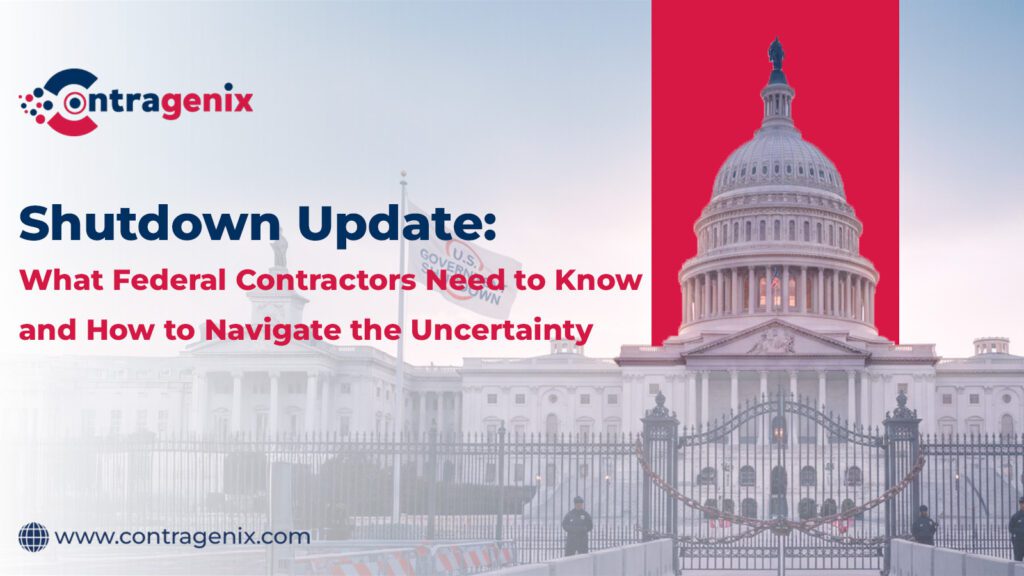Shutdown Update: What Federal Contractors Need to Know — and How to Navigate the Uncertainty

Introduction
The U.S. government shutdown is more than a budgetary gridlock — it’s a disruption with far-reaching consequences across the federal contracting community. As the Pentagon rolls out contingency plans, and programs like SBIR and STTR temporarily expire, contractors are left in an uncertain environment where contracts stall, compliance becomes murky, and long-term business strategies are tested.
At Contragenix, we understand the weight this places on small and mid-sized businesses — the lifeblood of innovation in the federal ecosystem. Our role is not only to provide proposal development expertise but also to stand as a partner during moments when the rules change and the ground shifts beneath your feet. In this article, we’ll break down what the shutdown means for federal contractors, the hidden risks, and most importantly — how you can safeguard your pipeline and keep moving forward.
The Shutdown Landscape: A Quick Breakdown
-
Defense Department Planning: According to reporting, the Pentagon has prepared its contingency plans to maintain essential operations, but non-critical programs face delays. For contractors, this means slowed procurement cycles, payment delays, and paused new contract awards.
-
SBIR and STTR Program Expirations: The Small Business Innovation Research (SBIR) and Small Business Technology Transfer (STTR) programs have expired during the shutdown. This cuts off a critical funding stream for startups and small firms driving federal innovation.
-
Cybersecurity in Legal Limbo: Experts warn that cybersecurity information-sharing initiatives are in a gray area. With legal authorities tied to appropriations, shutdown conditions risk creating gaps in cyber defense coordination — affecting contractors supporting critical infrastructure.
-
Operational Delays: Everything from contract modifications to FAR Part 15 negotiations may face significant slowdown. The lack of available contracting officers further stalls progress.
The Contractor’s Dilemma
For federal contractors, a shutdown creates a unique double bind:
-
Cash Flow Crunch: Invoicing may be disrupted, and with delays in disbursement, businesses — especially small firms — face cash flow risks.
-
Pipeline Uncertainty: Bids under review, debriefs, and scheduled proposal submissions may be postponed indefinitely
-
Compliance Questions: Contractors supporting cyber or data-driven programs may face compliance ambiguity if statutory authorities lapse during the shutdown.
Strategic Actions to Mitigate Impact
Despite the challenges, contractors are not powerless. Here are strategies that can help steady your business during this period:
1. Strengthen Client Communication
-
Maintain open dialogue with contracting officers, even if response times slow down.
-
Document all communications to create a clear record of delays.
-
Proactively ask for updated timelines once operations resume.
2. Secure Cash Flow
-
Explore bridge financing, lines of credit, or alternative funding sources.
-
Revisit accounts receivable and prioritize outstanding invoices.
-
For small businesses, consider partnerships to pool resources.
3. Protect Your Pipeline
-
Continue preparing proposals as if deadlines remain unchanged — this ensures you’re ready once agencies reopen.
-
Focus on pipeline diversification: balance defense, civilian, and state opportunities.
-
Use the downtime to strengthen your capture strategy and improve win themes.
4. Address Workforce Morale
-
Be transparent with your employees about project impacts and potential downtime.
-
Explore reassignments or internal upskilling to keep staff engaged.
-
Show empathy: employees are also facing uncertainty, and reassurance matters.
5. Reassess Risk Management
-
Evaluate contracts most at risk of delay or cancellation.
-
Review compliance requirements, especially in cybersecurity, where ambiguity could expose contractors to risk.
-
Build contingency planning into your Q4 strategy.
Long-Term Implications for Contractors
While shutdowns are temporary, their ripple effects are not:
-
Innovation Bottlenecks: With SBIR and STTR programs stalled, the innovation pipeline risks losing momentum — particularly for small businesses depending on this funding.
-
Cybersecurity Gaps: Legal uncertainty in information sharing may slow progress in strengthening national cyber resilience.
-
Erosion of Trust: Repeated shutdowns create skepticism in long-term partnerships between agencies and contractors.
Contractors that plan ahead and diversify their portfolios are better positioned to weather these storms. The shutdown may be a setback, but it is also a reminder of the importance of agility in the federal space.
Contragenix Stands With You
We know this is more than just a line item in the news cycle — it’s payrolls, proposals, and partnerships on the line. At Contragenix, we’ve walked with contractors through past shutdowns and periods of uncertainty. Our team can:
-
Help you identify stable contracting opportunities even during slowdowns.
-
Strengthen proposal pipelines so you’re not losing ground.
-
Build compliance strategies that adapt to shifting requirements.
Most importantly, we are committed to ensuring federal contractors — particularly small and growing firms — emerge stronger on the other side.
A Call to the Federal Contracting Community
Shutdowns are moments of stress, but they are also moments of solidarity. Federal contractors are the backbone of government operations, from defense innovation to cybersecurity to mission-critical services. As a community, your adaptability and resilience continue to prove indispensable.
